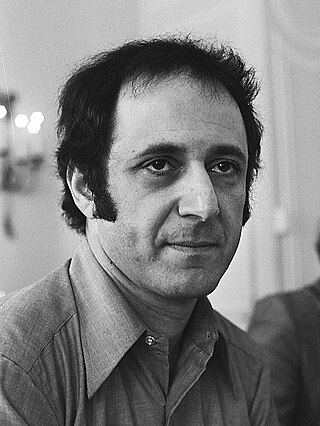
Louis Joseph Andriessen was a Dutch composer, pianist and academic teacher. Considered the most influential Dutch composer of his generation, he was a central proponent of The Hague school of composition. Although his music was initially dominated by neoclassicism and serialism, his style gradually shifted to a synthesis of American minimalism, jazz and the manner of Stravinsky.

Stephen Michael Reich is an American composer who is known for his contribution to the development of minimal music in the mid to late 1960s. Reich's work is marked by its use of repetitive figures, slow harmonic rhythm, and canons. Reich describes this concept in his essay, "Music as a Gradual Process", by stating, "I am interested in perceptible processes. I want to be able to hear the process happening throughout the sounding music." For example, his early works experiment with phase shifting, in which one or more repeated phrases plays slower or faster than the others, causing it to go "out of phase." This creates new musical patterns in a perceptible flow.
Music for a Large Ensemble is a piece of music written by Steve Reich in 1978. It is scored for violin 1, violin 2, cellos, 2 flutes, 2 clarinets, 2 soprano saxophones, 4 trumpets, 4 pianos, 2 marimbas, vibraphone, 2 xylophones and two female voices.

Meredith Jane Monk is an American composer, performer, director, vocalist, filmmaker, and choreographer. From the 1960s onwards, Monk has created multi-disciplinary works which combine music, theatre, and dance, recording extensively for ECM Records. In 1991, Monk composed Atlas, an opera, commissioned and produced by the Houston Opera and the American Music Theater Festival. Her music has been used in films by the Coen Brothers and Jean-Luc Godard. Trip hop musician DJ Shadow sampled Monk's "Dolmen Music" on the song "Midnight in a Perfect World". In 2015, she was awarded the National Medal of Arts by Barack Obama.
Music for 18 Musicians is a work of minimalist music composed by Steve Reich during 1974–1976. Its world premiere was on April 24, 1976, at The Town Hall in the Midtown Manhattan Theater District. Following this, a recording of the piece was released on the ECM New Series in 1978.
Violin Phase is a musical work written by minimalist composer Steve Reich in October 1967.
The Desert Music is a work of music for voices and orchestra composed by the minimalist composer Steve Reich. It is based on texts by William Carlos Williams and takes its title from the poetry anthology The Desert Music and Other Poems. The composition consists of five movements, with a duration of about 46 minutes. In both its arrangement of thematic material and use of tempi, the piece is in a characteristic arch form (ABCBA). The piece was composed in 1983 and had its world premiere on 17 March 1984 in Cologne, Germany.

Six Pianos is a minimalist piece for six pianos by the American composer Steve Reich. It was completed in March 1973. He also composed a variation for six marimbas, called Six Marimbas, in 1986. The world première performance of Six Pianos was in May 1973 at the John Weber Gallery in New York City. The European première took place in January the next year in Stuttgart, Germany.

Sextet is a composition by American composer Steve Reich. The piece was written and first performed in 1984, and slightly revised in 1985.

City Life is a minimalist composition by Steve Reich written in 1995. The work was commissioned by Ensemble Modern, the London Sinfonietta, and the Ensemble Intercontemporain. It premiered in March 1995 and was recorded on the Nonesuch label in 1996.
Century Rolls is a piano concerto by the American composer John Adams. Commissioned by Emanuel Ax, the work dates from 1997. Ax was the soloist in the concerto's premiere on September 25, 1997 in Cleveland, Ohio, with Christoph von Dohnányi conducting The Cleveland Orchestra. Ax, von Dohnányi and The Cleveland Orchestra made the first commercial recording of the concerto, for Nonesuch. Adams himself conducted the UK premiere on 1 November 1998, again with Ax as the piano soloist.
Proverb is a musical composition by Steve Reich for three sopranos, two tenors, two vibraphones, and two electric organs. It sets a text by Ludwig Wittgenstein from the year 1946 and published in Culture and Value. It was written in 1995 and was originally intended for The Proms and the Utrecht Early Music Festival. It was premiered at Alice Tully Hall in New York City on February 10, 1996 by Theatre of Voices with Paul Hillier, to whom the piece is dedicated.

Stuart Saunders Smith is an American composer and percussionist. After having studied composition and music theory at three music institutions, Smith is currently based in Vermont, United States, with his wife Sylvia. He has produced almost 200 compositions, half of which were written for percussion instruments with a focus on the vibraphone.

Drumming is a piece by minimalist composer Steve Reich, dating from 1970–1971. Reich began composition of the work after a short visit to Ghana and observing music and musical ensembles there, especially under the Anlo Ewe master drummer Gideon Alorwoyie. His visit was cut short after contracting malaria. Classical music critic K. Robert Schwarz describes the work as "minimalism's first masterpiece".
Steve Reich: Works 1965–1995 is a 1997 10-CD box set of compositions by composer Steve Reich released by Nonesuch Records as part of Reich's 60th birthday celebration. Described as, "monumental... essential... beautiful", it includes full track and personnel listing, career chronology, appreciative notes, a new interview, and "his most famous works" with the "curious exclusions" of Violin Phase, Music for Pieces of Wood and Vermont Counterpoint.
Naive and Sentimental Music is a symphonic work by American composer John Adams. The title of the work alludes to an essay by Friedrich Schiller, On Naïve and Sentimental Poetry, that contrasts a creative personality that creates art for its own sake versus one conscious of other purposes, such as art’s place in history. The composer cites both the slowly developing harmonies of Bruckner's Fourth Symphony and the atmosphere of the Sonoma coastline as inspirations for the work. The piece was co-commissioned by the Los Angeles Philharmonic, the Ensemble Modern, the Vancouver Symphony Orchestra, and the Sydney Symphony Orchestra. It received its first public performance by the Los Angeles Philharmonic conducted by Esa-Pekka Salonen on February 19, 1999. A recording by Salonen and the Los Angeles Philharmonic was subsequently released by Nonesuch Records.
Bob Becker is an American percussionist and composer known primarily as a founding member of the Nexus percussion ensemble, as well as a performer in the Steve Reich and Musicians ensemble. He primarily performs as a keyboard percussionist, but is also skilled in tabla and concert snare drumming. As a composer, Becker employs a multicultural approach by mixing the style of western military drumming with North Indian Hindustani idioms, such as raga scale patterns and tabla drumming. This fusion of compositional practices is the main focus of works like Lahara and Mudra. There are also traces of influence from the music of minimalists like Steve Reich, which can be attributed to Becker's experience with that composer's music.
Route 66 is a single-movement composition for orchestra by the American composer Michael Daugherty. The piece was commissioned by the Kalamazoo Symphony Orchestra and premiered on April 25, 1998, at the Irving S. Gilmore International Keyboard Festival in East Lansing, Michigan under conductor Yoshimi Takeda.
The Percussion Concerto No. 2 is a concerto for solo percussion and orchestra by the Scottish composer James MacMillan. The work was jointly commissioned by the Netherlands Radio Philharmonic, the Philharmonia Orchestra, the Orchestre national du Capitole de Toulouse, the Cabrillo Festival of Contemporary Music, the Baltimore Symphony Orchestra, and the São Paulo State Symphony. It was first performed on November 7, 2014 at TivoliVredenburg in Utrecht, the Netherlands, by percussionist Colin Currie and the Netherlands Radio Philharmonic under conductor James Gaffigan. The composition is MacMillan's second percussion concerto after 1992's Veni, Veni, Emmanuel.

Music for 18 Musicians is a minimalist album by composer Steve Reich recorded between April–December 1976 and released on the ECM New Series in April 1978—his first of three releases for the label. The ensemble features eighteen musicians, including Reich himself playing the part of piano and marimba, playing Reich's titular composition.









